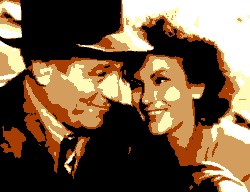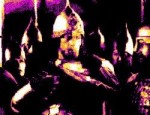Film Review

Despite winning an Oscar (as well as Best Actress award at Cannes for its female star Isa Miranda(, Au-delà des grilles is one of René Clément's most overlooked films, perhaps because it too closely resembles the poetic realist melodramas of an earlier decade (most visibly Marcel Carné Le Quai des brumes). The film's main strength is a subtly subversive script supplied by the unbeatable team of Jean Aurenche and Pierre Bost, who are best remembered today for their remarkable collaborations with director Claude-Autant Lara - Douce (1943), Le Diable au corps (1947), L'Auberge rouge (1951). Far from emulating the poetic realist aesthetic (which had by this time well and truly run its course), Aurenche and Bost give this an ironic twist that allows them to weave a complex study in human nature that is both unsettlingly ambiguous and chillingly dark.
It is the unfathomable perversities of the subconscious mind, not the workings of some mythical cosmic mischief-maker, that decide the fate of the protagonists in this, Clément's bleakest film. Marta's compassion for the fugitive Pierre is as understandable as her daughter's feelings of envy when the stranger takes her place in her mother's affection. What is harder to make sense of is the strength of feeling that Pierre - the disillusioned homicidal lover - develops for a woman he barely knows, a bond of such magnitude that it ultimately overcomes his instinct for self-preservation. In contrast with classic poetic realism, which makes scant allowance for free will, it is Pierre himself who makes the fatal call that will lead to his destruction. The neo-realist style which Clément skilfully appropriates for his film (with much of it shot on location in the busy port of Genoa) further serves to distance it from the old school fatalism of the 1930s French melodrama, bringing a modern naturalist sheen to the performances that can only heighten its crushing emotional impact.
For its male lead Jean Gabin, this was a crucial film, its popularity effectively helping to re-launch his screen career in France after the war, following an aborted attempt to 'make it big' in Hollywood in the early 1940s. On his return to his homeland, the actor had scored a moderate success in Georges Lacombe's Martin Roumagnac (1946), alongside his real-life lover Marlene Dietrich. This film and its immediate successor, Raymond Lamy's prototypical polar Miroir (1947), had been panned by the critics to the extent that Gabin's future career in France was far from assured. The national and international success of Au-delà des grilles did not allow Gabin to instantly reclaim his erstwhile iconic status but it put him in a place where subsequent hits - such as Jacques Becker's Touchez pas au grisbi (1954) and Jean-Paul Le Chanois's Les Misérables (1958) - would guarantee his return as a leading light of European cinema.
© James Travers 2022
The above content is owned by frenchfilms.org and must not be copied.
Film Synopsis
Pierre is on the run from the police, careful to evade capture after murdering the mistress who dared to be unfaithful to him. He is safe in a cargo ship bound for the Italian port of Genoa when he is suddenly afflicted with a raging toothache. Unable to bear the pain, he steals away from the ship and sets out in search of a dentist, but in doing so his wallet is stolen. Without a penny to his name, things look bleak for the fugitive, and then he meets Marta, a young waitress in a restaurant. Like Pierre, she has been unlucky in love. After breaking up with her cheating husband, she lives alone with her teenage daughter, Cecchina.Taking pity on the desperate runaway, Marta offers him what little help she can, and it is through her kind support that Pierre manages to avoid being caught by his determined pursuers. Cecchina's attitude towards him is far less benign, however. Realising that her mother is falling in love with Pierre, the girl becomes bitterly jealous and sees him as an unwelcome rival for her mother's affections. Concealing her growing hatred for the fugitive, Cecchina offers to help him find his way back to the ship that is still docked in the port. Even with the prospect of escape within his grasp, Pierre just cannot bring himself to leave Marta, but by staying in Genoa he seals his fate. Cecchina's obsessive jealousy leads her to betray him to the authorities.
© James Travers
The above content is owned by frenchfilms.org and must not be copied.
Similar Films
Here are some other films you may enjoy watching:- Nuit de décembre (1940)
- Les Cousins (1959)
- Three Strange Loves (1949)
- All That Heaven Allows (1955)
- Sunset Boulevard (1950)
Other related links:
Film Credits
- Director: René Clément
- Script: Jean Aurenche, Pierre Bost, Cesare Zavattini, Suso Cecchi D'Amico, Alfredo Guarini
- Cinematographer: Louis Page
- Music: Roman Vlad
- Cast: Jean Gabin (Pierre Arrignon), Isa Miranda (Marta Manfredini), Vera Talchi (Cecchina), Andrea Checchi (Giuseppe), Robert Dalban (Le marin), Ave Ninchi (Maria, la voisine), Checco Rissone (Le faux-monnayeur), Renato Malavasi (Le dentiste), Carlo Tamberlani (Le commissaire), Vittorio Duse (L'agent), Agnese Dubbini (La patronne de l'auberge), Claudio Ermelli (Le curé), Fulvia Fulvi (Laura), Ermanno Randi (Un agent de police), Michele Riccardini (Le patron du restaurant), Dina Romano (La fleuriste), Marietta Campello, Alessandro Fersen, Giuseppe Garello, Franca Lumachi
- Country: Italy / France
- Language: Italian / French
- Support: Black and White
- Runtime: 95 min
- Aka: Le mura di Malapaga ; Beyond the Gates ; The Walls of Malapaga
The best of Japanese cinema

The very best period film dramas

The greatest French Films of all time
